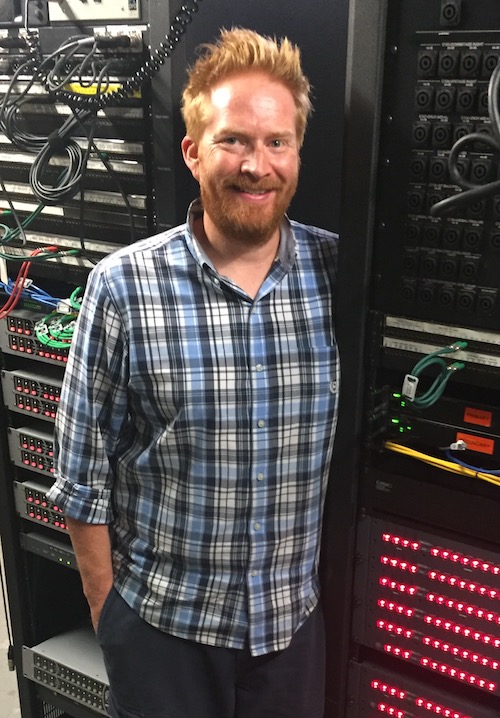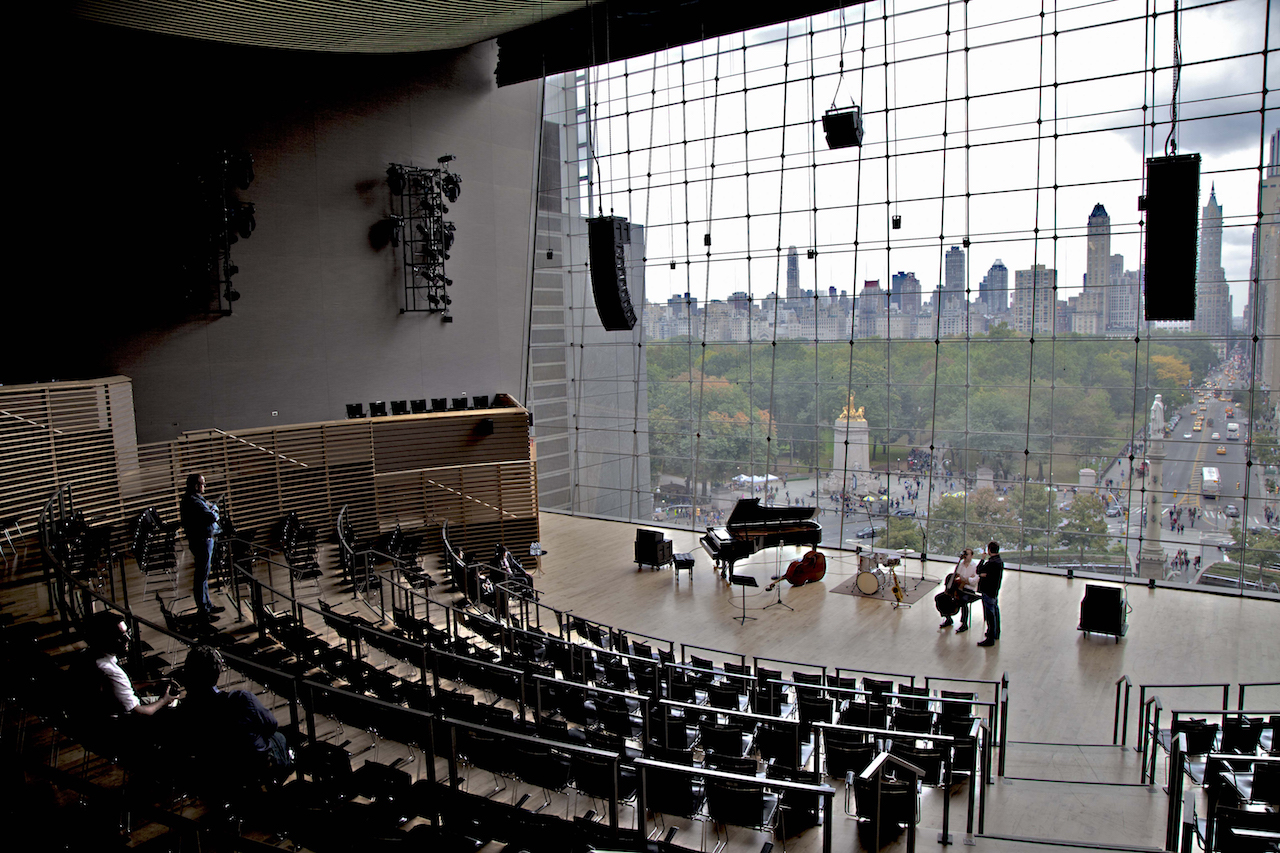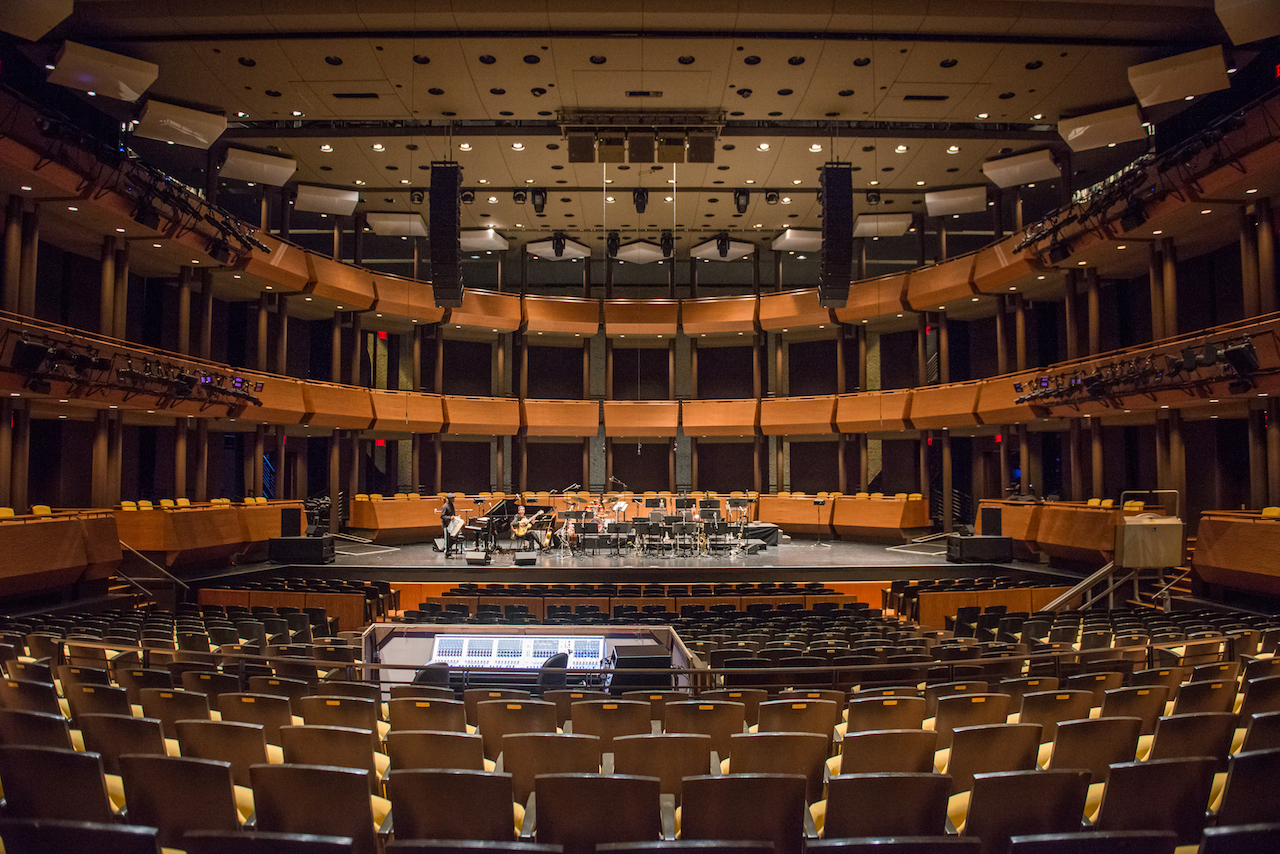AV Behind the Scenes: Jazz at Lincoln Center
Director of production John Starmer discusses the sound system at one of NYC's premier performing arts venues
When an artistic mind sets its zest to technology, amazing things can happen. For proof, look no further than John Starmer, director of production at Jazz at Lincoln Center. A theater pro who once aimed to be an actor, Starmer now oversees the AV systems for one of New York’s most prestigious performance venues—and he’s drawing on his artistic roots to push its audio technology to creative new places.

“All of the people around me would definitely say [I’m not a tech guy],” Starmer said. “But I’m always willing to work with that group of people to go ‘OK, what’s next? How do we take this back down to its component pieces and make something new out of it?’”
Curtains Up
Starmer is quick to attribute the source of his professional success to his education. Though he aspired to be an actor, his bachelor of arts program at Catawba College—a small liberal arts school in North Carolina—pushed him to expand his horizons. “Being in a school like that, you didn’t get a degree in acting; you got a degree in theater, in everything,” he said. “So I built sets, I designed sound, I did lights, and had the opportunity to do everything that they would let me do.”
[Testing Out Meyer Sound’s Revolutionary Spacemap Go Spatial Sound Tool]
Upon graduation, he did work some stints as an actor, but realized more professional potential lay in the technical side of things. He made his way up from building scenery for regional theater and opera to working as a theatrical technical director, and later enrolled at Yale School of Drama for a master’s degree in production management.

While at Yale, Starmer began to add some tech chops to his repertoire. He took some audio classes and was introduced to the possibilities of using video to transform productions. “At the time, I had done a couple shows that had involved video before going there,” he said. “But really, in my experience, 2000-2006 the video world in theater specifically exploded, and really became what it is today.”
Not long after getting his degree, the opportunity to work at Jazz at Lincoln Center arose, and he took it, even though he was reluctant to commit to a career path set in routine. “I had been a freelancer and I couldn’t imagine walking into the same building over and over and over again for years,” he said. “At the time it was like ‘I’m going to be here, I’m going to make my mark, I’m going to do what I need to do, both for me and the company, and then I’m out.’”
A daily selection of features, industry news, and analysis for tech managers. Sign up below.
New Sounds
Fortunately for Starmer, his fears of becoming restless were quickly assuaged as he found himself in a position to drive change. ‘I got there at a time that was very advantageous,” he said. “I came about three years after the completion of construction of that venue, so at the right time where within a few years, we were looking at ‘OK, how do we make it better? What’s the next step?’”
Located on the fifth floor of the Time Warner Center in Manhattan’s Columbus Circle, Jazz at Lincoln Center opened in 2004 under the artistic direction of jazz and classical trumpet legend Wynton Marsalis. Run by a nonprofit organization of the same name, Jazz hosts performances in three venues within the Frederick P. Rose Hall: Rose Theater, The Appel Room, and Dizzy’s Club. The hall also contains an education center and recording facilities run by Sirius XM radio.
[Calgary Concert Hall Upgrades Meyer Sound System]
With Marsalis’ creative and technical fervor, the center had always employed top-notch sound reinforcement solutions. But, according to Starmer, the advancements in technology in the intervening years led to a quick reconsideration of possibilities. “From 2003 to 2010, huge leaps happened in every form of technology, and audio and video were certainly a part of that,” he said. Along with his boss Doug Hosney, they began to explore ways of bringing the facility’s sound up to the cutting edge.
The team eventually settled on solutions from Meyer Sound, and installed them in all of the performance spaces. “All of the venues had systems that were fantastic but just needed a different fidelity,” Starmer said. “It’s really about dialing in that level of precision that Meyer was able to give us.”
The upgrade began with the installation of Meyer M’elodie compact arrays in the Appel Room, a 500-seat amphitheater, and led to the team switching the front presents in the other two halls to Meyer-based systems as well. Then, when they learned about Meyer Sound’s Constellation acoustic system, the team sprang for it for the Appel Room and installed it in 2013.

Designed to allow the custom tailoring of acoustics to provide optimal sound across a range of environments and for a variety of music styles, Meyer’s Constellation is a dream come true for creative sound designers. In the Appel Room, the system incorporates 83 Meyer MM-4XP miniature loudspeakers in the ceiling, behind the walls, and along the upstage floor; six Meyer UP-4XP ultra-compact loudspeakers as stage-side fill; and 16 Meyer MM-10 miniature subwoofers. All of the speakers in the Appel Room system are controlled by a pair of Meyer Sound Galileo 616s with full compass software control at the FOH mix positions.
But Starmer and his team wanted to take things even further. Though engineered for live performances, the team employs the system for various cinema and video applications, using the surround speakers to complement the P.A. “We like to take the systems as designed and ‘dismantle’ them (not necessarily physically) to use the components for other applications,” he said. “Obviously, Constellation still works beautifully for its designed purpose as a standalone system, but having the ability to tap into the individual parts of the system for other uses gives us so much flexibility. But, that has to be part of the initial design process, or it becomes more difficult to accomplish.”
Starmer and his team also installed a 131-speaker Meyer Sound Dolby Atmos system in the 1,200-seat Rose Theater concert hall—and they also designed it from the start to be pliable to their creativity. “Their primary purpose is for us to press a button and play Dolby Atmos-mixed films,” he said. “But our real drive is what’s next; what else can I do? How can I create an immersive environment with a live event, be that music, be that dance—whatever that is—and how can I use the equipment that we have in a way for which it wasn’t necessarily designed?”
Rounding out the upgrades, Dizzy’s Club, a 130-seat jazz supper club, employs a main system of five Meyer UPA-1P loudspeakers with UPJ-1Ps for side fills, four UMS-1P subwoofers, and one UPM-1P for delay.
Keeping Up
During the pre-COVID peak, Starmer said the venue was averaging 10-plus events per week. “Finding time in that sort of schedule to keep all of that equipment humming as it should, that’s probably our biggest challenge,” he said. Given the complexity of the sound systems and their innovative ways of utilizing them, it’s quite a challenge indeed. “How we sort of have all those parts available for us to utilize makes it even more challenging,” he said. “Because on Tuesday we might take it apart, and on Wednesday we need it to work like it was originally designed. (And I don’t necessarily mean take it physically apart, but software and patching and all of that stuff.)”
Starmer credits his adeptness in juggling the system setups to his team of stage hands and production managers. “The subtleties really fall to those guys and me, to be like, ‘Wait, let’s not forget that we’re doing this on Tuesday and need to be ready for this other thing by the end of the week,’” he said. Good communication is also key. “It really comes from our production office: we both literally and figuratively have an open-door policy,” he said. “Our door’s rarely closed, and if it is, it’s because something really loud is happening outside of it.”
[Audio's Next Frontier: 3D Soundscapes]
In addition to overseeing the venue’s sound systems, Starmer’s department is also in charge of the other AV systems, which include two large video walls, 23 smaller digital signage monitors, a QSC Q-SYS controlled in-ceiling speaker system, and a Crestron control system that ties everything together and provides a “seamless environment” for guests moving about the space.
“We have an LED wall in one space, and an LCD monitor wall in another space that are all running off of that, coming through the Crestron to a WATCHOUT [video wall system] that’s controlling those two walls,” he said. Though the walls are mainly used for signage—including playing video reels of performances and static posters throughout the day—the team occasionally uses them for more engaging applications. “We can livestream out of one venue onto the walls, and we’ve even used the walls to do PowerPoint presentations right from a laptop in the lobby space.” The team will also work with its video vendor partner WorldStage to run more sophisticated video performances like projection mapping on an event-needed basis.

What’s Next
With COVID-19 keeping everyone at home for the past year, it’s going to take some doing to get people out and about now that restrictions are being lifted and entertainment venues are reopening. While high-end, immersive facilities like Jazz have a leg up on other concert spaces, it may still require some creativity to lure crowds back. Starmer has some ideas for that.
“I think even before the pandemic we were headed in sort of a VR/AR world,” he said. “I’m fascinated to see—and I’m constantly chatting with my colleagues—about how the sort of ‘Zoom world’ and the VR world that’s going to be the next phase out of that [will translate to live events]. People are going to be itching to go back to venues, to go back to live events. But, there’s something nice that Zoom gives you, and that’s going to be the trick: creating that comfort that you have sitting in your living room in the live space, in the venue. And AR and immersive technologies are some of the things that are going to do that, I think.”
Starmer says the challenge will be finding a balance that enriches the experience without overwhelming it. “There’s a sort of Disney-ride version of that, where you’re in the chair with the heat and smoke, and the speakers right by your head,” he said. “And then there’s a subtler version of that that comes with live music and jazz, where there’s already an energy, there’s already a story being told. Let’s enhance that story, but not in a gimmicky way.
I think that’s going to be the challenge for technology moving forward, that balance. Now we can do it; but artistically, the key is going to be finding a way that works with the piece of art and the piece of performance that we’re doing, and not just do it because we can.”
Parting Advice
Starmer stresses that in order to obtain top-of-the-line technology systems like the ones he oversees, you have to get upper management excited. “We’re fortunate that we have an artistic head in Wynton Marsalis who is interested in the music, and the audio and acoustics and how the science behind all of that works,” he said.
But, for those less lucky in that regard, he suggests bringing in charismatic tech evangelists for a meeting. “I think that people like the folks at Meyer, people like WorldStage and Sound Associates here in New York who are genuinely excited by the technology have the ability to get other people excited by it,” he said. “[Management] can hear us say ‘This is great, this is great, this is great,’ but if they get somebody who is an industry expert outside of us who is regarded in some way to talk about it, it helps.” He also said that these kinds of people can help drive an upgrade by inspiring the spirit of competition. “They can also talk to: ‘I just did this thing in Durham, North Carolina,’ or wherever—there’s a little bit of ‘keeping up with the Joneses’ that can happen.”
Lastly, he urges others to apply the example of his theatrical education to their own professional development. “The biggest thing I see in young technicians these days is a lack of diversification,” he said. “That’s not to say that you can’t have an interest and a love, but it’s important to be able to understand [the work of] the other technicians and the other artists, and your other collaborators. And for me, the way to do that is to have walked in those shoes, at least for a little bit.”
Matt Pruznick is the former editor of AV Technology, and senior editor for Systems Contractor News and Residential Systems. He is based in New York.

